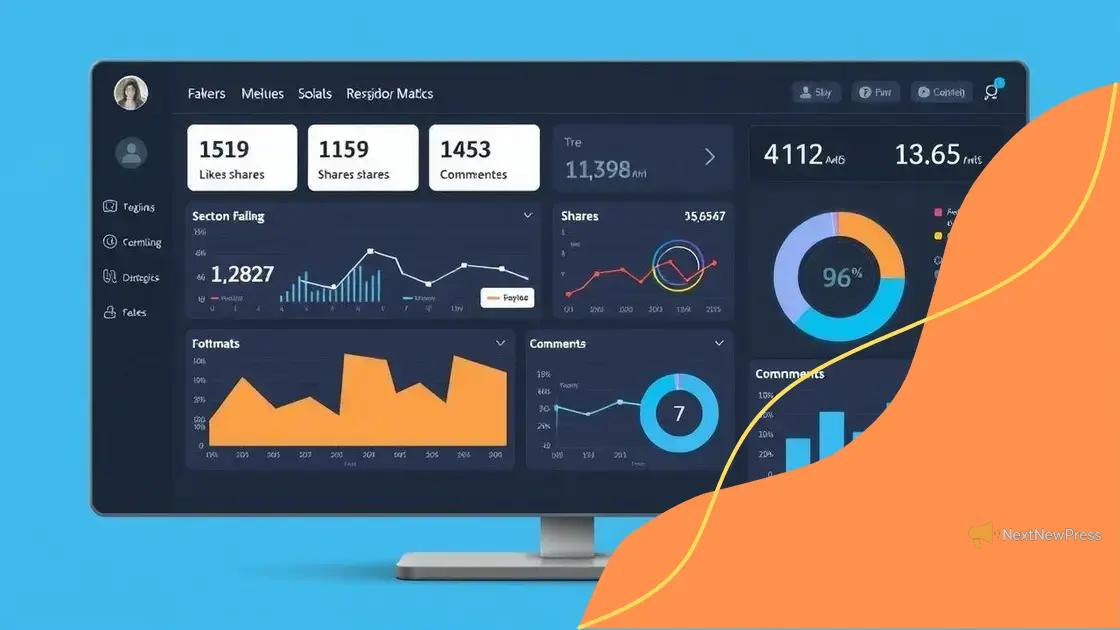Impact of social media algorithms on your online presence

The impact of social media algorithms shapes user experience by prioritizing personalized content, optimizing engagement through video and AI, and focusing on mental health and privacy protections.
Impact of social media algorithms on our daily lives is more significant than many realize. These algorithms determine what we see online, shaping our interactions. How does this influence the way you engage with content?
Understanding social media algorithms
Understanding social media algorithms is essential for anyone wanting to navigate today’s digital landscape. These algorithms guide the content we see online and influence how we interact with social media platforms.
When you scroll through your feed, the content presented is not random. Algorithms analyze your behavior—what you like, share, and comment on—to show you what is deemed most relevant to you. With this in mind, let’s dive deeper into how these algorithms function and why they matter.
How social media algorithms work
Social media algorithms are designed to prioritize content that the platform believes will engage you. This is accomplished through complex calculations based on various factors.
- User engagement: Likes, shares, and comments all indicate what content resonates with you.
- Relevance: The algorithm assesses how closely the content aligns with your interests and past interactions.
- Recency: Newer posts are often favored to keep content fresh and current.
As algorithms evolve, they become more sophisticated in predicting what will catch your eye. It’s a dance between user preference and platform goals, leading to a tailored experience.
Impact on user behavior
The ramifications of these algorithms extend beyond what we see; they influence how we consume content and interact with others. By curating a personalized feed, social media platforms can both enhance user experience and also create echo chambers.
Many users are unaware of how their interactions impact their feeds. For instance, if you comment frequently on specific topics, you are likely to see more of that type of content. This can lead to an overwhelming influx of similar perspectives, limiting exposure to diverse viewpoints.
Additionally, the platforms continuously adapt these algorithms to enhance engagement. As users change their behavior, the algorithms also shift to accommodate new patterns, creating a constantly evolving environment.
Why understanding is crucial
For content creators and marketers, grasping how social media algorithms operate is vital. This understanding can guide strategies to increase visibility and engagement.
- Create engaging content: Understand what your audience prefers.
- Post regularly: Consistency helps maintain relevance in the algorithm.
- Anatomy of your posts: Use hashtags and capitalized words wisely to reach broader audiences.
By tapping into the intricacies of algorithms, you can better position your content to reach the right audience at the right time.
In conclusion, understanding the impact of social media algorithms is not just beneficial for creating effective content; it’s essential for fostering genuine connections and enriching the online community.
How algorithms influence user behavior
How algorithms influence user behavior is a crucial aspect of understanding social media today. Algorithms not only determine what content you see, but they also shape how you interact with that content.
When users engage with posts—such as liking, sharing, or commenting—they inadvertently teach the algorithms about their preferences. This data is then used to tailor future content, resulting in a cycle of reinforcement where users are shown more of what they like. This creates patterns in user behavior that can be both beneficial and limiting.
Feedback loop of engagement
The engagement a user has with a platform generates feedback that affects their experience. For instance, if you frequently engage with posts about fitness, the algorithm will prioritize similar content. This can lead to:
- Increased exposure to preferred topics, enhancing user satisfaction.
- Potential narrowing of perspectives by limiting exposure to diverse opinions.
- Encouragement of habitual behavior, as users gravitate towards familiar content.
While this makes your experience feel personalized, it can also lead to an echo chamber effect, where only similar viewpoints are presented.
Shaping perceptions and preferences
The influence of algorithms extends beyond just content visibility; they also shape users’ perceptions and preferences. By frequently showing particular types of content, algorithms can create a bias towards specific ideas or lifestyles.
This impact is evident in how trends emerge and evolve. For example, a viral video or a trending hashtag can quickly gain prominence due to algorithmic preferences, pushing users to engage with that content. This rapid cycling of trends can lead to a distorted view of what is popular or important, skewing user behavior.
Awareness of how algorithms steer user behavior helps individuals take control of their digital experience. Users can seek out diverse perspectives and intentionally engage with different content to broaden their horizons.
As these algorithms continue to evolve, understanding their impact on behavior becomes even more vital. By recognizing the mechanics at play, users can make informed choices in their interactions across social media platforms.
The role of engagement metrics

The role of engagement metrics is significant in understanding how content performs on social media. These metrics provide insights into what users like, share, and comment on, and they ultimately guide the algorithms in determining what content gets promoted.
Engagement metrics, such as likes, shares, comments, and views, are crucial for creators and marketers. They measure how well content resonates with the audience. The more engagement a post receives, the more likely it is to be seen by a larger audience.
Key engagement metrics to monitor
Some of the most important engagement metrics include:
- Likes: Indicate basic approval and interest in the content.
- Shares: Show that users find the content valuable enough to share with their friends.
- Comments: Reflect deeper engagement and interest, as users take the time to express their thoughts.
- Click-through rates: Measure how often people click on links shared in posts, indicating interest beyond just viewing.
By focusing on these metrics, creators can tailor their content to generate more interaction and visibility. This can result in a cycle where increased engagement leads to better algorithmic placement.
Why engagement metrics matter
Understanding the significance of engagement metrics is essential for anyone using social media. These metrics not only help gauge content performance but also inform future content strategies.
Marketers use engagement metrics to refine their campaigns. If a particular type of post generates high engagement, they may produce more similar content to maintain audience interest. Additionally, these metrics can impact decisions on content timing and platform choice.
For individual users, being aware of these metrics can enhance their social media experience. By recognizing what kind of content engages them most, users can seek out and create posts that foster better interactions.
Ultimately, engagement metrics play a critical role in shaping the social media landscape, influencing both user behavior and content strategy.
Tips for optimizing content for algorithms
Tips for optimizing content for algorithms are essential for anyone looking to enhance their online presence. By aligning content with the way algorithms operate, you can improve visibility and engagement on social media platforms.
Creating content that resonates requires an understanding of algorithmic preferences. Here are some effective strategies to consider:
Use relevant keywords
Incorporating keywords is crucial for optimization. Identify terms and phrases that your audience searches for and include them naturally in your content. This helps algorithms connect your posts with users’ interests.
- Research trending keywords in your niche.
- Use long-tail keywords to target specific audiences.
- Place keywords in titles, captions, and throughout your posts.
By focusing on the right keywords, you improve the chance your content will be found by the right people.
Engage your audience
Engagement is a powerful factor in how algorithms rank your content. Prioritize creating engaging posts that encourage users to react. Content that inspires comments and shares promotes increased visibility.
Consider the following when crafting your posts:
- Ask questions to provoke discussion.
- Use compelling visuals to capture attention.
- Create polls or quizzes to boost interaction.
When users engage with your content, the algorithms see it as valuable, likely resulting in greater reach.
Post consistently
Consistency is key to optimizing for algorithms. Regularly posting content signals to the platform that you are active, helping maintain your visibility. Develop a content calendar to plan your posts.
A well-planned schedule helps establish expectations among your audience. When followers know when to expect new content, they are more likely to engage with your posts.
Additionally, consider experimenting with different types of content. Videos, stories, and images can perform differently in terms of engagement and visibility, so try to vary your approach while monitoring responses.
Implementing these optimization strategies can significantly enhance your content’s performance in a competitive social media landscape. Understanding and adapting to algorithm preferences is crucial for maximizing your reach.
Future trends in social media algorithms
Future trends in social media algorithms are shaping the way we interact online. As technology evolves, so do the algorithms that determine what content we see. Here are some emerging trends that could impact social media in the coming years.
One key trend is the increasing importance of video content. Platforms like Instagram and TikTok have already made significant shifts towards favoring video, leading other platforms to follow suit. As users seek more dynamic and engaging experiences, algorithms are adapting to promote video content more prominently.
Rise of artificial intelligence
Artificial intelligence (AI) is becoming integral to social media algorithms. With advanced data analytics, AI can better understand user preferences and behaviors. This means content will be increasingly tailored to individual users, enhancing their interaction with platforms.
- AI can analyze engagement patterns to predict what users want to see.
- Machine learning enables algorithms to evolve based on feedback.
- Personalization is set to become even more sophisticated, creating unique user experiences.
As platforms utilize AI, users may find themselves engaged with content that feels more relevant and enticing.
Emphasis on mental health and well-being
Another critical trend is the focus on user mental health. Social media platforms are beginning to prioritize content that fosters well-being over purely engagement-driven metrics. This could lead to algorithms that reward positive interactions and healthy content.
Initiatives to reduce harmful content will likely reshape how algorithms operate. By promoting supportive and constructive posts, platforms hope to create a more positive online environment.
Users may see a shift in their feeds, with a growing emphasis on content that encourages connection, kindness, and community support.
Privacy and data protection
Concerns about privacy are influencing the design of social media algorithms. As regulations and user awareness increase, platforms are becoming more transparent about data usage.
Future algorithms will likely incorporate privacy-first approaches, meaning:
- Less reliance on personal data for targeted advertising.
- Greater user control over what data is shared.
- Transparency in how user data is used and protected.
These changes could further alter how algorithms operate, focusing on building trust and safeguarding user information.
Keeping an eye on these trends can help users and content creators adapt and thrive in the evolving landscape of social media.
FAQ – Questions About Future Trends in Social Media Algorithms
How will video content shape social media interactions in the future?
As platforms increase the importance of video, users can expect more engaging content that captures attention and encourages interaction.
What role will artificial intelligence play in social media algorithms?
AI will enhance personalization, improving how content is matched to user preferences and behaviors.
Why is mental health awareness becoming a trend on social media?
Platforms aim to promote positive interactions and reduce harmful content, focusing on user well-being and constructive dialogue.
How will privacy concerns affect social media usage?
Increased focus on privacy will lead to more transparent practices and give users greater control over their personal data.





